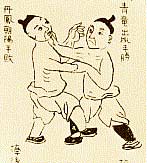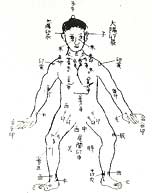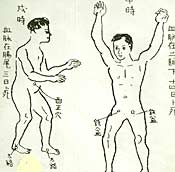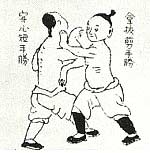Enter The bubishi
Part 2- The Text & Its Impact On
Okinawa
By Victor Smith

Editor's Note:
This is the second article in a three part series
on the bubishi. Part
1 discussed the book's origin and introduction
through the writings of many early 20th century karate
masters. Part 3 will discuss the availability of translations
of the text in English, the text's impact on karate
today and the current status of research on this text.
The bubishi has over 30 chapters (depending on the
edition) that focus on a wide variety of topics, including
martial history, fighting strategy, vital point striking,
hand positions, essential fighting techniques, grappling
and escapes, herbal medicine treatment, forms and
techniques and martial code. It also offers some history
on the White Crane and the Monk Fist Kung Fu arts.
Patrick McCarthy in his translation of the text ("bubishi:
The Bible Of Karate") has organized the book's
information into four general categories, or parts.
He also includes an Introduction and historical perspective.
These parts include:
Part 1- Articles on history, concepts, strategy
and philosophy including White Crane and Monk Fist
Kung Fu.
Part 2- Articles, examples, definitions, diagrams
and recipes for Chinese medicine, specific remedies
and herbal pharmacology, including the concept of
12 hours chi (energy) flow (shichen cycle).
Part 3- Vital points including types, locations,
diagrams, periods for attack, restricted locations,
and delayed death touch.
Part 4- Fighting techniques, a list of kata moves,
eight principles, maims, principles, six open hand
positions, 48 self-defense diagrams, and Shoalin
hand and foot, muscle and bone training postures.
While many topics are discussed, most of the information
is presented in outline form and thus for most readers
will seem incomplete. For this reason many of the
topics can not be fully understood from the limited
information presented. For example, while the bubishi
offers many illustrations of vulnerable points, it
does not explain how to strike them, or what technique
to use. Thus many important details behind these practices
are missing.
This lack of detail lends some credence to the theory
that the bubishi may have been a personal notebook
rather than a textbook. If the author had been in
a martial training program, the notes taken would
have been cryptic, something designed to work as a
mnemonic device for future reference.
But the reader should not be discouraged, for there
are some fascinating chapters. For example, the bubishi
presents the principle of striking vital points according
to the Shichen theory of Traditional Chinese Medicine.
The theory states that body energy (chi in Chinese
or ki in Japanese) flows in natural cycles or tides
through the body and its organ systems, with each
24 hour cycle being divided into 12 two hour periods.
Based on this theory, certain points are more active
and more deadly during certain two hour periods. Thus
knowledge of where the Chi flow is during a particular
Shichen cycle allows the martial artist to locate
the most vulnerable points which could be struck.
Both the points and the optimum time for striking
them are illustrated. The text often suggests death
as the outcome, immediately or after differing periods
of time after being struck. (1)
|
In a different light, certain sections of the
bubishi could be seen as a medical text. The
charts showing where to strike vital points,
the charts showing the vulnerability of those
points during specific Shichen, as well as the
"correct" treatment for those injuries
might suggest the points are shown only for
medical treatment purposes.
|
 |
|

|
Another section purportedly shows secret points
that can be struck that will have a killing
effect one-half or one year later. In some Chinese
arts this is known as the "Death Touch,"
or "Dim Mak."
|
The bubishi also contains considerable information
relating to fighting. It contains lyrical descriptions
of forms: some versions of the bubishi show a diagram
of techniques, possibly from a form (kata). There
are also discussions of combat principles and a lengthy
discussion on grappling and escapes.
|
Another interesting segment includes 48 Self
Defense Diagrams. In each case the outcome of
an encounter is shown. Both the winning and
losing technique are listed along with a short
synopsis of the strategy that led to victory.
Here again, however, there is minimal discussion
about how techniques can be applied.
|
 |
Some authorities suggest that the practice of Okinawan
Karate may have been influenced by these 48 diagrams.
Many similar techniques can be found in many Okinawan
karate kata as well as part of self-defense exercise
sets. (2)
There are also chapters explaining herbal treatment
for illness and injuries. Except for anecdotal evidence
it is not known if these practices work or not. In
addition some translators have noted that mistakes
have crept into copies of the text, probably as a
result of people copying by hand information which
they are not familiar. (3)
I would suggest that these herbal formulas should
be carefully examined and not be experimented with,
except under the supervision of a trained expert in
Traditional Chinese Medicine knowledgeable in herbal
formulations.
The Impact Of The bubishi On Okinawa
We know the bubishi existed, but how do we track
the actual influence it had on the development of
the Okinawan arts?
We know that some important karate masters in the
past possessed copies of the bubishi, but there are
no published notes, direct studies, or even oral history
on the text's influence available for our review.
Also, exactly who and how many people possessed copies
of the text is open to which "legends" one
wishes to listen to.
Thus many questions arise:
Was the bubishi truly kept private for the select
few?
Were those who possessed the bubishi sufficiently
literate to read and understand the text which was
written in an older style Chinese dialect? And if
they could read the text, did they possess enough
knowledge of Traditional Chinese Medical theory to
use and apply the information?
Was the bubishi used to design training, such as
teaching the defensive theories directly to the students?
Or was the bubishi little more than a learned curiosity,
something valued but not understood, something to
be placed on the shelf to be revered but not actually
used?
Without historical proof, it is very difficult to
know the truth. We know that Mabuni, Funakoshi and
Yamaguchi felt the bubishi was important enough to
"announce" its existence by including portions
of the text in their own works. Others famous masters,
such as Higaonna, Itosu, Nakamura and others also
had the text and passed it on to their most trusted
students.
Miyagi Chojun also felt so strongly about the bubishi
that he reportedly took the term "Goju"
from it as the name for his system of training. According
to Patrick McCarthy (The Bible Of Karate: bubishi),
Miyagi took the name Goju from a section of the bubishi
titled, "The Eight Precepts of Quanfa" which
speaks of inhaling as representing softness ("Ju"
of Goju) and exhaling as characteristic of hardness
("Go" of Goju). (4)
Others suggest, however, that while Miyagi was influenced
by the bubishi, he took his style name from other
sources. (5) Material
in the bubishi may also have provided Miyagi with
inspiration for developing his famous Tensho (Rolling
Hands) kata.
Tatsuo Shimabuku (the founder of Isshinryu) chose
the eight poems of the fist (Chapter 13) of the bubishi
to be the Isshinryu Code of Karate.
But not everyone considers the bubishi to be influential.
Miyazato Eiichi, a long time student of Miyagi and
one of the principal inheritors of his system, believed
the bubishi was not important. He did not have a private
copy, however, and said that he had only seen it a
few times. (6)
As to the impact of the bubishi's sections pertaining
to chi meridian theory, there is no evidence that
they were used in the historical development of Okinawan
karate. Certainly there existed knowledge of vital
points and methods to strike them which relate to
acupuncture points. But, there is no evidence that
this knowledge was taken to a much more complicated
level which involved understanding not only concepts
of energy flow, but also related timing patterns.
From what I've heard, there is no evidence that the
Okinawans ever referred to the Meridian charts."
There have been many explanatory books and commentaries
written on the bubishi in Japan, none of which are
available in English. I also strongly suspect there
are many instructors who have prepared extensive analyses
concerning the bubishi, but this information is not
readily available to the martial arts community. A
great deal of time is likely being spent following
the same lines of thought over and over again due
to the unavailability of research and analysis of
the texts contents and theory.
Footnotes:
(1) Christopher Caile in a
communication with this author has noted that in addition
to the 24 hour cycle of Chi, what is also important
but unstated in the bubishi, is that chi theory (in
Traditonal Chinese Medicine) also includes a larger
yearly cycle that greatly influences the daily cycle.
Thus a technique based on the daily cycle will be
much more effective when done at a certain period
of the year. This, however, is not discussed within
the bubishi.
(2) Conversation with George
Donahue, a member of the Kishaba Juku organization,
related the following observation about the bubishi
to Christopher Caile: His organization has passed
down the work for five generations, having made hand
copies of the manuscript along with many notes. Donahue
believes, however, that the most useful information
is contained within the notes (overlays of onion skin
with notes) themselves. Included are critiques of
information within the bubishi including what works
and what doesn't. Thus, while the bubishi is considered
important in itself, it did not significantly influence
his organization or its teachings. One of the bubishi
copies, Donahu noted, was originally from Nakamura
sensei. Another one passed down is from the late Kishaba
sensei. Donahue's teacher and head of the organization,
Shinsato sensei, has collected, annotated and bound
a lot of information on the bubishi and other texts.
(3) Miyagi was well aware
of the bubishi and even quoted from the book in an
August 1942 essay that appeared in "Bunka Okinawa"
that was titled "Breathing In And Breathing Out
In Accordance With "Go" And "Ju":
A Miscellaneous Essay On Karate." Notice the
similarity of the essay's name with the section from
the bubishi after which Miyagi is reputed to have
named his style. It is perhaps this similarity that
led some to suggest that "Goju" as the name
for Miyagi's style came from this source.
(4) A more likely derivation
for Goju karate's name lies elsewhere. Representing
Miyagi at a 1930 All Japan Martial Arts Exhibition
was his senior student Jinan Shinzato who was asked
the name of his ryuha (school). Shinzato. The style
having no formal name at the time other than association
with its Nahate, Surite and Tomorite lineage, and
Shinzato replied to the question, "Goju"
(meaning hard/soft). This was later related to Miyagi,
who adopted the name. Others, however, suggest that
Shinzato never gave an answer to the question about
the name of his ryuha and that Miyagi later coined
the name after thinking the problem over.
(5) Information supplied by
Christopher Caile. In 1992 Caile had a private
translation made of the 39 pages from the bubishi
that appeared in Yamaguchi's book, "Karate-Goju-Rui
By The Cat." The translator, who is well versed
in Chinese herbal medicine, noted numerous inconsistencies
, possible errors, as well as the names of herbs not
generally recognized. It was suggested that these
unknown herbs might have been local herbs, or local
names for well-known herbs. Furthermore some methods
ofpreparation are not fully explained.
(6) From a private interview of Miyazato by Christopher
Caile held in Naha, Okinawa, while Mr. Caile was studying
in Miyazato's dojo in December, 1994.
About The Author:
Victor Smith is a respected teacher of Isshinryu
karate (6th degree black belt) and tai chi chuan
with over 26 years of training in Japanese, Korean
and Chinese martial arts. His training also includes
aikido, kobudo, tae kwon do, tang so do moo duk
kwan, goju ryu, uechi ryu, sutrisno shotokan, tjimande,
goshin jutsu, shorin ryu honda katsu, sil lum (northern
Shaolin), tai tong long (northern mantis), pai lum
(white dragon), and ying jow pai (eagle claw). Over
the last few years he has begun writing on, researching
and documenting his studies and experiences. He
is the founder of the martial arts website FunkyDragon.com/bushi
and is Associate Editor of FightingArts.com. Professionally
he is a business analyst, but also enjoys writing
ficton for the Destroyer Universe.

back
to top
home
| about
us | magazine
| learning
| connections
| estore
|